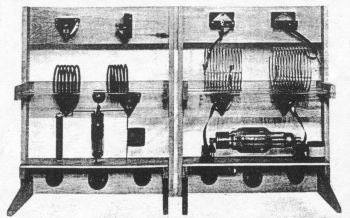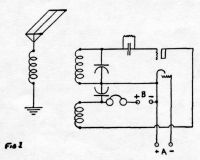A.A. Collins:
Amateur Radio:
1925 Radio Age •••
- Article
|
Radio Age Article
| RADIO AGE for November, 1925 |
The Magazine of the Hour 11 |
Riding the SHORT WAVES
BY ARMSTRONG PERRY |
 |
Amateur Radio
Station 9CXX,
owned by
Arthur A. Col-
lins of Cedar
Rapids, Ia.
Note the effici-
ent equipment
and "calls
heard" on the
wall.
|
|
Work of Young Amateurs is Responsible
for Remarkable Development in Short Wave
Work; Many Records Made by U. S. Boys
|
SOME TIME ago it was discovered that extremely short radio waves, from five to forty meters in length, would cover
distances far greater than those in common use. Their range was discovered to be practically as great in daylight as in darkness and
static did. not materially interfere with their reception. Radio amateurs were prompt in following up this discovery, as they have been
in developing many new things in radio. One of the best known members of the American Radio Relay League, which includes most of the amateur
experimenters, went as a Naval Reserve officer on the Seattle, during the recent cruise of our Pacific fleet. This was F. H. Schnell;
traffic manager. A Navy officer reported, after Schnell and his short wave set had established communication with amateurs in many countries, that all Schnell had to do was to press the key of his
short-wave transmitter and he would be heard in any part of the world.
Then John L. Reinart, known to all amateurs as well as in professional radio circles; went. with the. MacMillan Arctic expedition in the
summer of 1925, taking short-wave apparatus on the last previous Arctic
expedition conducted by MacMillan, which sailed in the summer of 1923 and spent the
|
winter within eleven degrees of the North Pole, a prominent amateur named Donald Mix represented the American Radio
Relay League and kept the expedition in touch with the world most of the time. He was out of communication for two months at one time, when
a fifteen-year-old boy, Everett Sutton, of Port Angeles, Washington,
picked up his signals and took scores of messages, which were delivered per instructions, to friends and relatives of the officers
and crew, to the press and organizations interested in the expedition. Again in the Summer of I925 it was a fifteen-year-old boy, Arthur A.
Collins of Cedar Rapids, Iowa, who succeeded in keeping in touch with the Arctic expedition, using the shorter wave- lengths, when older and
more experienced radio men were unable to keep up communication.
Age Is No Barrier THE fact that in two successive years mere boys should have been able to render such noteworthy service,
|
indicates that amateurs of any age have a most
attractive field for investigation in short-wave work, A visit to the
station of Arthur Collins, at Cedar Rapids, showed me that his
apparatus is simpler and less expensive than the average radio bug
would think possible. Convincing proof of its efficiency is shown by
hundreds of reports from brother hams who have received his signals in
all parts of the United States and in Mexico, Hawaii, Cuba, Porto
Rico, Scotland, England, Belgium, Chile, Guam, Tahiti, India, New
Zealand and Australia. While broadcast listeners are using receivers
with five to nine tubes, Collins hears signals from distant countries
with three tubes. He made his receiver. The inductance coils have each
a few turns of rather large wire, insulated by double cotton covering.
The ends go directly to binding posts on the panel. There is no
mounting, knob, dial or other device for changing the coupling. If
Collins wants to put the primary nearer the secondary, or the tickler
nearer either, he bends them over with his fingers. The coils were
wound on, a square box. When taken off, the wire had a tendency to
uncoil. It was permitted
|
| 12 RADIO AGE for November, 1925 |
The Magazine of the Hour |

1KW (left) and 50-watt (right) transmitters of
Arthur A. Collins, 9CXX, of Cedar Rapids. It is
with this equipment the the young amateur is
achieving remarkable distance records.
|
The National Geographic Society, which sponsored the expedition, sent and received numerous messages through this station, built and operated by a boy, with complete
satisfaction. The 1KW tube uses 4,000 volts on the plate. The only source of supply was the circuit which supplied light and power for the house.
That carried raw AC, which is not ideal. Pulling 4,000 volts from the lighting circuit every time the transmitting key was pressed stole most of
the juice from the lamps around the house and the family led a flickering existence until Arthur ran a heavy 3-wire BX cable up from the main
entrance box and thus put the 21-ampere load of the transmitter on a separate circuit.
The 1KW transmitter uses what is known as the 1XAM circuit. (Described in QST, January, 1924.) When working amateur
stations in Australia and New Zealand, as he frequently does, Collins tunes it to 40 meters. While working WNP, MacMillans flagship Bowdoin,
he used wavelengths of 15, 16 and 21 meters. Both transmitters look even simpler than the receiver, as the photograph shows. His antenna, during
the time he was handling the traffic with the Arctic, was a single wire inefficiently lying in a tree. Having built a dream of a house, on Colonial lines, his parents were thinking more of architectural beauty
than of scientific achievement, and poles are likely to be unsightly. But since Arthur established his remarkable record there have been
erected on the roof two thirty-foot masts. At the top is a 50-foot single-wire aerial and twenty feet lower a 48-foot counterpoise. There is not much radio territory left for Arthur to reach, unless it might be
the moon and Mars, but with this increase in the efficiency of his station he should be able to dig up a few hams in Africa, Thibet and
Corea, if there are any there. It is just such experimenters as Arthur Collins who make the amateur radio game one of the most interesting and
beneficial hobbies for the rising generation to ride. Men of mature years could profitably emulate the young ones, too, and many of them do. With the low-priced and efficient equipment now available, there is
certain to be a big increase in the number of radio students, or "bugs"
this winter. Anyone feeling the urge to get into the game, but uncertainjust what are the beginners first steps, will do well to confer with
the technical staff of Radio Age. Information cheerfully given upon any phase of radio.
|
to relax far enough so that the corners alternated. Thus coils that
would have been square, like the box, became circular with humps at
regular intervals. This caused the turns to pass each other at an
angle instead of being parallel, and reduced the capacity between
turns. Collins says, however, that straight-wound coils would serve as
well, that is, coils wound turn after turn on a cylindrical form but
removed from the form in order to avoid the effects its material might
produce. The condensers, he says, should be of the very best material
and workmanship available. Of course, the capacities used must be
nicely adjusted to the inductances in order to cover the desired
wavelengths. The tuning condenser has seven plates.
The circuit, shown in figure 1, is a conventional one known by various
names. The term “low loss,”
originated at the headquarters of the American Radio Relay League, has
been applied to many types of apparatus but does not always describe
accurately the characteristics of the apparatus or the financial
result to the purchaser. The receiver for very short waves, however,
must be a low-loss receiver to be efficient. Collins uses his without
a ground connection, sacrificing volume of sound in the phones for
greater selectivity. He has eliminated everything that can be
dispensed with, in order to get rid of inductive and capacity effects
that are undesirable. He has no vernier controls, except a rubber on
the end of a lead pencil which he uses at times as a friction gear in
turning a dial. His theory is that if a clear signal, however faint,
can be brought in, it can be amplified.
Using two stages of audio-frequency amplification he brought in the
voices of the men on the Bowdoin when they were broadcasting
from north of Greenland. They were so loud and distinct that they could be heard ten feet from the phones and all over his radio room.
|
As will be seen in the diagram, turning the dial that controls regenerationdoes not change the wavelength. The tuning is done with
one dial and the only other one is that which controls the regeneration. The whole receiver is simplicity simplified and it can
be built and operated by anyone who can construct and operate any type of receiver.
Has Two Transmitters
COLLINS has two transmitters, one rated at 50 watts and the other at 1,000 watts. Even the 50-watt outfit was used successfully in
working the Bowdoin. Both were designed for high electrical efficiency, convenience and flexibility of operation, as he likes
experimental work. It was the day after the tube for the big set was installed and tested that Collins became the only connecting link between the
explorers and the folks back home. For twenty-two days he was the only operator in communication with the expedition. He worked from 8 a.m. to 5 p.m.

Fig. 1. Wiring Diagram of short wave receiver used by Arthur A. Collins for receiving messages and broadcasts from WNP, the Bowdoin of
the Mac Millan Arctic expedition. The two stage amplifier when used is added in the usual fashion. The circuit is the conventional regenerative patterned after Armstrong.
daily and handled a great volume of traffic, including personal and
official messages and articles for the newspapers.
|
|
|


